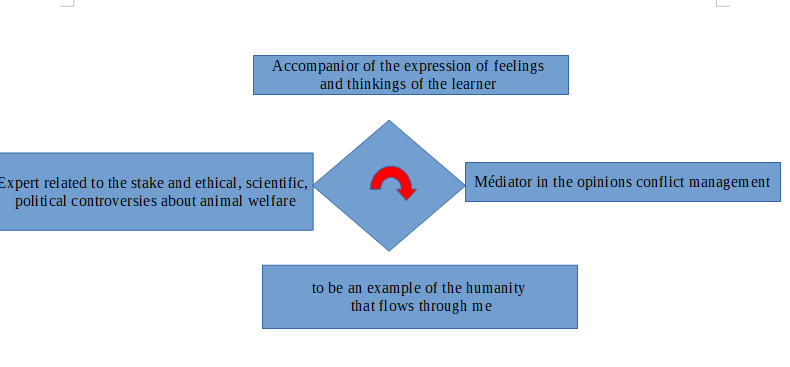How to choose a relevant posture adapted to different pedagogical situations
Issue: educators are perhaps more accustomed to positioning themselves as experts. This posture is relevant, but in a constructivist perspective, it makes sense at the end of a pedagogical process, once the institutionalization stage has taken on its full meaning for the learner in the light of the experience gathered during the pedagogical process. In addition to the expert stance, there are several other postures to be taken in consideration.
Objective
For the trainer: to analyse the different postures adaptable to a pedagogical situation
For the trainee: to understand the importance of having a posture adapted to their pedagogical objectives, to take a coherent posture.
Stances to be considered in a socio-constructivist approach
Whatever the pedagogical situation, it is important to remain impartial, i.e. not to direct the learner towards a personal point of view (educator) on the issue of animal welfare, not to try to convince them but rather to show all the controversies involved. The teacher will only reveal his/her own opinions to set an example, or to respond to participants' requests. But under no circumstances should these same opinions be used as a model to be followed. The educational ethic that the teacher expresses is based on acceptance of the student's subjective experience.
This key posture implies adaptation to other different postures during the pedagogical approach.
The facilitation posture aims to allow expression of conceptions and confront learners’ opinions in a fair atmosphere. To question and allow everyone's points of view to be explored in greater depth requires that one's own norms, ethics and point of view regarding animal welfare issues be disregarded.
The mediation posture is particularly solicited when students have expressed conflicting points of view, to help participants to their divergences into consideration in a constructive manner.
Welcoming a person's emotions, allowing him/her to express these, is part of an accompanying posture, leading the teacher to help the learner to orient himself/herself. Any judgment made about his/her choices would risk disqualifying his subjective experience.

But the teacher must also be able to express any difficulties, not to incriminate the group, but to testify to the emotions present and the underlying desires. This posture is an invitation for the learner to do the same, to allow themselves to be authentic. It also generally leads to regulation of the group by allowing participants to experience the same discomfort leading to change.
Pitfalls and recommendations
As a teacher, it is important to be clear about the posture to take according to the pedagogical situation, avoiding being an expert when leading a debate, or avoiding orienting the learner more than accompanying him/her.
Examples et testimonials
“The first test of the Anicare didactic approach that was carried out with veterinary students in Belgium was quite disappointing for the facilitator. Indeed, the students did not present the expected motivation to participate in the debate. After debriefing, we identified several obstacles. Because of the place he occupied in the room (sitting on a high chair at the extremity of the table in front of the blackboard) and the situation/problem chosen (practical case with only one solution), the facilitator positioned himself as an expert.”
“During a workshop with teachers of zootechny, the participants didn’t know if they could share their own ethical point of view about some professional practices with others, and how to do that without feeling too exposed. A teacher testified that he wanted to be impartial with his learners but at the same he needed to give his own opinion about calf dehorning. “ I have read research articles, I have observed breeders with their animals, I have dehorned, and for me, the calves suffer for a long time. It’s difficult for me to accept that, even if I have to teach you such practices”. He enabled the students to give their own experience, without any proselytism, without the need for justification in an attempt to prove a point.
The myth of the neutrality of the teacher collapsed. A teacher can express his/her own opinion without taking a position and trying to convince. Finally, the conclusion of the discussion with the teachers turned to legitimacy. What does it mean to be legitimate? To be the knowledge expert or your capacity to manage a discussion, a debate?”
“I've often had problems with ranchers' sons. No matter how many virtuous practices I showed them, they kept saying, "Yes, but my father, he doesn't do it like that." They don't question themselves. I preferred to work with novices. But now I make the students exchange among themselves, without intervening and I observe that they accept better the difference in outlook.”












